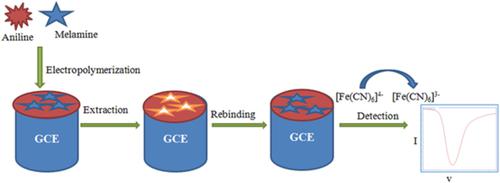当前位置:
X-MOL 学术
›
J. Mol. Recognit.
›
论文详情
Our official English website, www.x-mol.net, welcomes your feedback! (Note: you will need to create a separate account there.)
Molecularly imprinted polyaniline molecular receptor-based chemical sensor for the electrochemical determination of melamine.
Journal of Molecular Recognition ( IF 2.7 ) Pub Date : 2020-02-03 , DOI: 10.1002/jmr.2836 Melkamu B Regasa 1 , Tesfaye R Soreta 2 , Olu E Femi 1 , Praveen C Ramamurthy 3 , Saravana Kumar 3
Journal of Molecular Recognition ( IF 2.7 ) Pub Date : 2020-02-03 , DOI: 10.1002/jmr.2836 Melkamu B Regasa 1 , Tesfaye R Soreta 2 , Olu E Femi 1 , Praveen C Ramamurthy 3 , Saravana Kumar 3
Affiliation

|
Molecularly imprinted polymer‐modified glassy carbon electrode (GCE)‐based electrochemical sensor is prepared using the electropolymerization of aniline in the presence of melamine (MA) as a template. In this work, the advantages of molecularly imprinted conducting polymers (MICPs) and electroanalytical methods were combined to obtain an electronic device with better performances. The sensor performance was evaluated by cyclic voltammetry (CV) and square wave voltammetry (SWV) with the linear range of 0.6‐16 × 10−9M, quantification limit of 14.9 × 10−10M, and detection limit of 4.47 × 10−10M (S/N = 3). The selectivity of the sensor was tested in the presence of acetoguanamine (AGA), diaminomethylatrazine (DMT), casein, histidine, and glycine interfering molecules taken at the triple concentration with MA that demonstrated too small current response compared with that of the analyte indicating high specificity of the sensor towards the template. The sensor was successfully applied to determine MA in infant formula samples with significant recovery greater than 96% and relative standard deviation (RSD) less than 4.8%. Moreover, the good repeatability, recyclability, and stability make this sensor device promising for the real‐time monitoring of MA in different food stuffs.
中文翻译:

基于分子印迹聚苯胺分子受体的化学传感器,用于三聚氰胺的电化学测定。
在三聚氰胺(MA)作为模板的情况下,使用苯胺的电聚合制备了基于分子印迹聚合物改性玻璃碳电极(GCE)的电化学传感器。在这项工作中,结合分子印迹导电聚合物(MICP)和电分析方法的优点,获得了性能更好的电子器件。通过循环伏安法(CV)和方波伏安法(SWV)评估传感器性能,线性范围为0.6-16 × 10 -9 M,定量限为14.9 × 10 -10 M,检测限为4.47 × 10 - 10M(信噪比 = 3)。在乙酰胍胺 (AGA)、二氨基甲基莠去津 (DMT)、酪蛋白、组氨酸和甘氨酸干扰分子的存在下测试了传感器的选择性,这些干扰分子以 MA 的三倍浓度采集,与分析物的电流响应相比,表明电流响应太小,表明高传感器对模板的特异性。该传感器已成功应用于测定婴儿配方奶粉样品中的 MA,显着回收率大于 96%,相对标准偏差 (RSD) 小于 4.8%。此外,良好的重复性、可回收性和稳定性使该传感器装置有望用于实时监测不同食品中的 MA。
更新日期:2020-02-03
中文翻译:

基于分子印迹聚苯胺分子受体的化学传感器,用于三聚氰胺的电化学测定。
在三聚氰胺(MA)作为模板的情况下,使用苯胺的电聚合制备了基于分子印迹聚合物改性玻璃碳电极(GCE)的电化学传感器。在这项工作中,结合分子印迹导电聚合物(MICP)和电分析方法的优点,获得了性能更好的电子器件。通过循环伏安法(CV)和方波伏安法(SWV)评估传感器性能,线性范围为0.6-16 × 10 -9 M,定量限为14.9 × 10 -10 M,检测限为4.47 × 10 - 10M(信噪比 = 3)。在乙酰胍胺 (AGA)、二氨基甲基莠去津 (DMT)、酪蛋白、组氨酸和甘氨酸干扰分子的存在下测试了传感器的选择性,这些干扰分子以 MA 的三倍浓度采集,与分析物的电流响应相比,表明电流响应太小,表明高传感器对模板的特异性。该传感器已成功应用于测定婴儿配方奶粉样品中的 MA,显着回收率大于 96%,相对标准偏差 (RSD) 小于 4.8%。此外,良好的重复性、可回收性和稳定性使该传感器装置有望用于实时监测不同食品中的 MA。


























 京公网安备 11010802027423号
京公网安备 11010802027423号